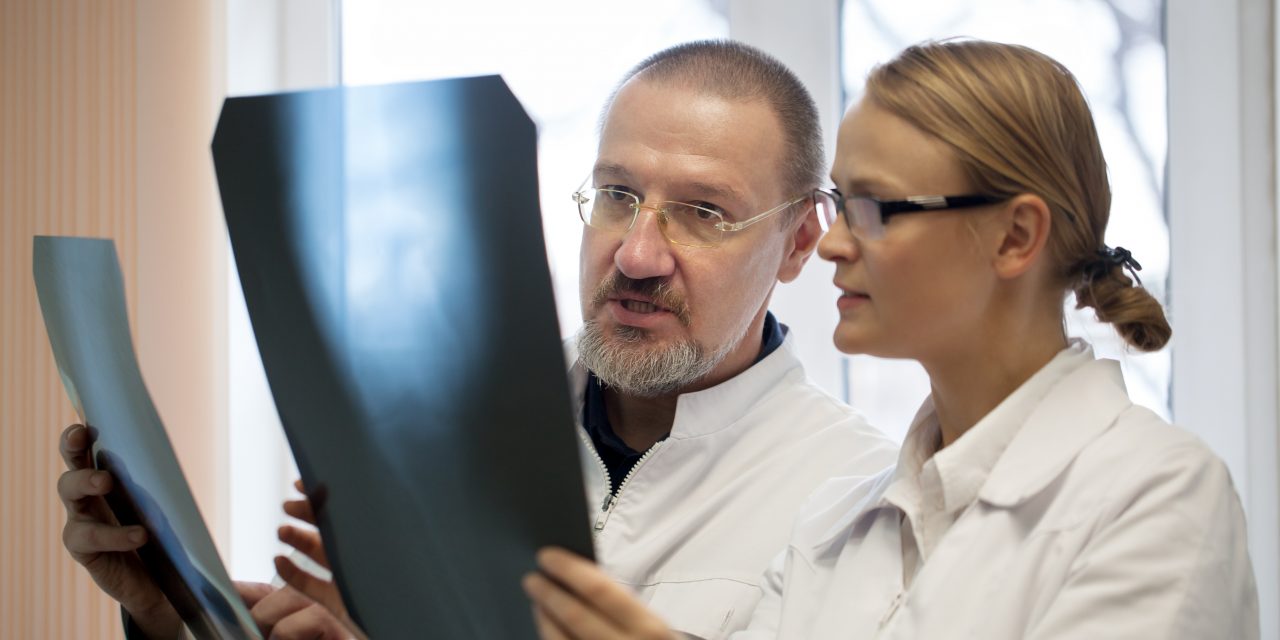
Lumbosacral Referral or Hip Osteoarthritis

As spine specialists, we are intimately familiar with the management of lumbosacral pain. We understand the presenting signs and symptoms better than other physicians and possess the most effective tools for managing these problems. This familiarity brings confidence, but may also lead to diagnostic bias, i.e. “when your favorite tool is a hammer, everything starts looking like a nail”.
Lumbosacral problems are common, but so is hip osteoarthritis (OA). Estimates for the prevalence of hip OA vary from 3-33%. However, the diagnostic challenge with this commonality is the fact that referral zones for lumbar and sacroiliac disorders are very similar to those of hip OA, i.e. gluteal pain is common in both (10). This month, we will review diagnostic clues for hip osteoarthritis.
Cartilage
Normal joint cartilage has a high water content providing it with the ability to change shape when compressed. A key function of cartilage is to serve as a “shock absorber.” In primary osteoarthritis, repetitive microtrauma irritates cartilage. The ensuing immune response causes swelling and softening, leading to surface damage. Chronically damaged cartilage is accompanied by the development of subchondral cysts, joint space narrowing, sclerosis and osteophytes that further disrupt joint mechanics, perpetuating degeneration and causing eventual deformity.
The likelihood of developing osteoarthritis increases with age, and the incidence appears to be slightly higher in males. There appears to be a genetic predisposition, and other predisposing factors for hip OA include obesity, congenital defects including femoroacetabular impingement (FAI), and repetitive trauma, including occupations requiring prolonged standing or heavy physical exertion (1).
Complaints
A thorough history and exam provide significant diagnostic clues for the differentiation of hip and lumbar conditions. An early presenting symptom of hip OA is prolonged stiffness upon arising (<60 minutes) and following periods of inactivity. The patient will often complain of the inability to put their socks on, shave their legs or climb stairs. Groin, anterior thigh, and buttock pain are common. The patient will often describe the location of their pain with the “C” sign, demonstrated by placing their index finger over the anterior aspect of the hip, near their ASIS, and their thumb over the posterior trochanteric region (2). Referral of pain below the knee may follow the distribution of the saphenous nerve (a branch of the femoral nerve) and is present in up to 47% of cases (3). The pain is gradually progressive from dull to sharp and increases with weight bearing. Crepitus may develop as the condition progresses.
Clinical evaluation of hip OA demonstrates tenderness to palpation, especially over the greater trochanter. The range of motion is diminished in a capsular pattern. Passive hip internal rotation is often less than 15 degrees and hip flexion may be less than 155 degrees. Active flexion and extension are often painful. Muscular assessment may reveal tightness in the psoas, adductors, quadratus lumborum, TFL, and piriformis. Weakness is common in the gluts, quadriceps, and hip external rotators.
Tests
Orthopedic tests that are useful for the clinical diagnosis of hip OA include Trendelenburg (4), FABER (5), Hip scouring (6), Hip quadrant (7), FADIR (8) and Thomas test (9).
Beyond the obvious consideration for lumbosacral problems, the differential diagnosis for hip OA includes trochanteric bursitis, iliopsoas tendonitis, labral injury, inflammatory arthropathy, fracture, infection, tumor, Padget’s disease, avascular necrosis, loose bodies, labral tears, and FAI. Hip pain may be secondary to nerve entrapment syndromes involving the ilioinguinal, genitofemoral or lateral femoral cutaneous nerve (11).
Radiographs are indicated for the assessment of hip pain in those over age 65, in cases of severe pain, or in those with a history of trauma, osteoporosis, cancer, corticosteroid use or alcohol abuse (12). Radiographic evidence of hip OA is common in seniors, although not all patients with radiographic degenerative changes will be symptomatic (1).
The following table summarizes plain film grading of hip OA (16).
| Grade | Joint Space Narrowing | Osteophytes | Sclerosis | Deformity |
| 1 | Possible | Subtle | Absent | Absent |
| 2 | Defined | Defined | Some | Absent |
| 3 | Marked | Small | Some | Mild |
| 4 | Gross | Large | Marked | Likely |
The presence of “red flags” warrants additional diagnostic work-up. MRI will certainly demonstrate the presence of OA and is useful to rule out a stress fracture, avascular necrosis or soft tissue injury. Lab evaluation with ESR (normal is >20mm/hr) may be useful to rule out inflammatory arthropathy or infection.
Treatment
Management of hip OA is directed at restoring motion and avoidance of aggravating factors. Hip capsule mobilization and HVLA axial elongation manipulation of the hip has been shown to be more effective than exercise therapy for short and long term gains in range of motion and pain reduction (13). Additionally, manipulation of lumbar and sacroiliac restrictions is appropriate.
Electroacupuncture and hydrotherapy programs have shown short-term relief (14,15), and hip OA patients should be strongly encouraged to participate in a water-based exercise program ranging from formal PT hydrotherapy to classes at their local health club. Although long-term benefits of non-water based exercise have yet to be demonstrated, stretching may be directed at the psoas, adductors, quadratus lumborum, TFL, and piriformis. Strengthening the glutes, quadriceps, hip external rotators, and core musculature may be beneficial.
Conclusion
Lifestyle recommendations should include losing excess weight and avoidance of aggravating activities, especially those that require internal rotation. Patients may consider the use of a cane (in the opposite hand) to take the weight off of the affected hip. NSAIDS and/or1500 mg of Glucosamine and chondroitin may be useful.
References
1. Lane, N. Osteoarthritis of the Hip. NEJM 357;14, Oct 4, 2007
2. Byrd J. Evaluation of the hip: history and physical examination. North American Journal Of Sports Physical Therapy: NAJSPT [serial online]. November 2007;2(4):231-240.
3. Khan, A.M., McLoughlin, E. Hip Osteoarthritis: Where is the Pain? Ann R Coll Surg Engl. 2004 March 86(2) 119-121
4. Bird P, Oakley S, ShnierR, Kirkham B. Prospective evaluation of magnetic resonance imaging and physical examination findings in patients with greater trochanteric pain syndrome. Arthritis And Rheumatism [serial online]. September 2001;44(9):2138-2145.
5. Martin RL, IrrgangJJ, SekiyaJK. The diagnostic accuracy of a clinical examination in determining intra-articular hip pain for potential hip arthroscopy candidates. Arthroscopy. 2008;38:542-550.
6. SutliveT, Lopez H, Childs J, et al. Development of a clinical prediction rule for diagnosing hip osteoarthritis in individuals with unilateral hip pain. Journal Of Orthopaedic& Sports Physical Therapy [serial online]. September 2008;38(9):542-550.
7. SuenagaE, Noguchi Y, Iwamoto Y, et al. Relationship between the maximum flexion-internal rotation test and the torn acetabular labrum of a dysplastic hip. Journal Of OrthopaedicScience: Official Journal Of The Japanese OrthopaedicAssociation [serial online]. 2002;7(1):26-32.
8. Martin RL, IrrgangJJ, SekiyaJK. The diagnostic accuracy of a clinical examination in determining intra-articular hip pain for potential hip arthroscopy candidates. Arthroscopy. 2008;38:542-550.
9. NarvaniA, TsiridisE, Kendall S, ChaudhuriR, Thomas P. A preliminary report on prevalence of acetabular labrum tears in sports patients with groin pain. Knee Surgery, Sports Traumatology, Arthroscopy [serial online]. November 2003;11(6):403-408.
10. Lesher, J., Dreyfuss, P., Hager, N. Hip Joint Pain Referral Patterns: A Descriptive Study. Pain Medicine Vol. 9(1), 2008
11. DeAngelis, Nicola A. MD; Busconi, Brian D. MD Assessment and Differential Diagnosis of the Painful Hip. Clinical Orthopedics. Volume 406, January 2003, pp 11-18
12. Margo, K., Drezner, J., Motzkin, D. Evaluation and Management of Hip Pain: An Alogrithmic Approach Journal of Family Parctice Vol 52(8) August 2003
13. Hoeksma HL, Dekker J, Ronday HK, et al. Comparison of manual therapy and exercise therapy in osteoarthritis of the hip: a randomized clinical trial. Arthritis Rheum 2004;51:722-9.
14. Stener-Victorin E, Kruse-Smidje C, Jung K. Comparison between electro-acupuncture and hydrotherapy, both in combination with patient education and patient education alone, on the symptomatic treatment of osteoarthritis of the hip. Clin J Pain 2004;20:179–85.
15. Cochrane T, Davey RC, Mattes Edwards SM. Randomised controlled trial of the cost-effectiveness of water-based therapy for lower limb osteoarthritis. Health Tech Assess 2005;9:1–114.
16. Altman R, Alarcon G, Appelrouth D, Bloch D, Borenstein D, Brandt K, et al. The American College of Rheumatology criteria for the classification and reporting of osteoarthritis of the hip. Arthritis Rheum 1991;34:505–14.

















